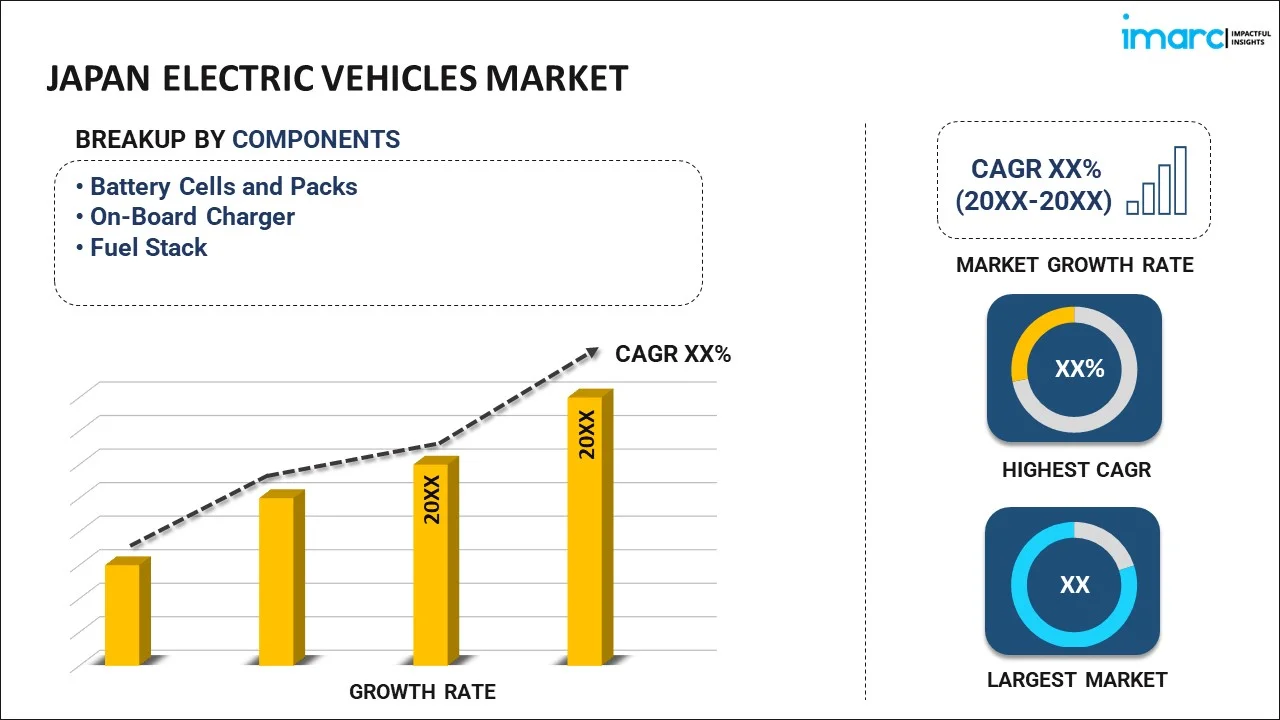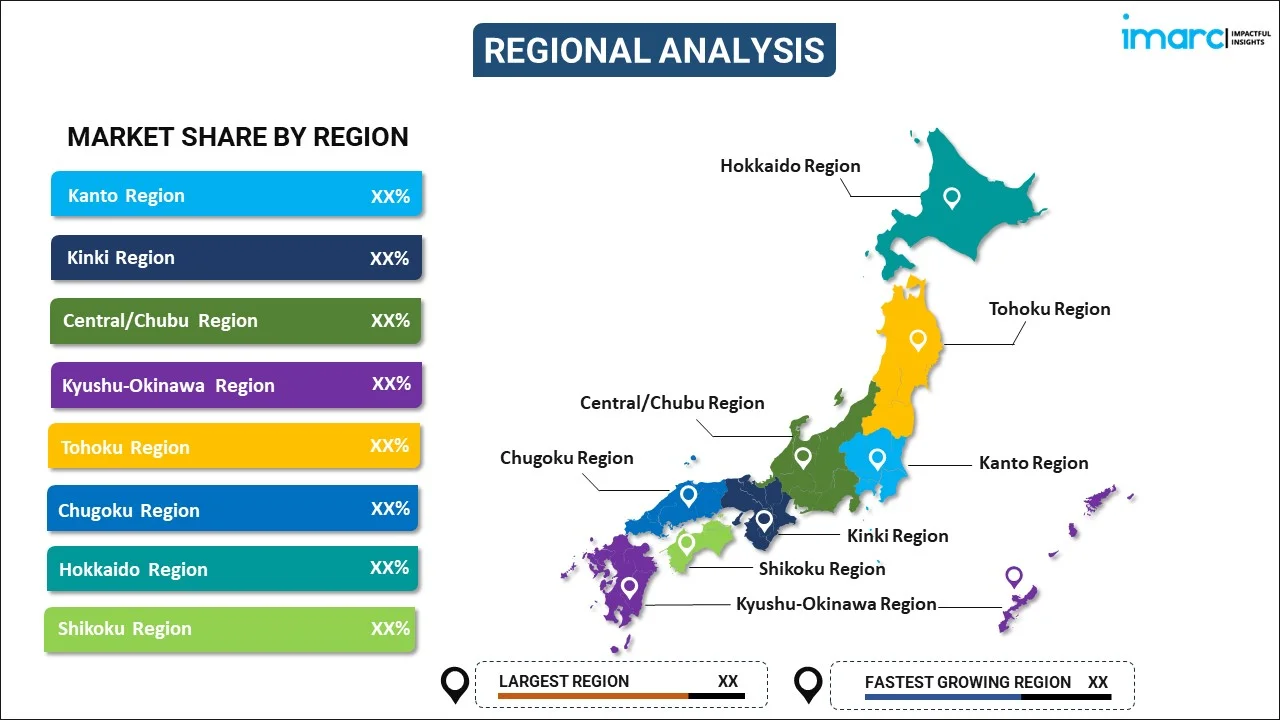
Japan Electric Vehicles Market Report by Component (Battery Cells and Packs, On-Board Charger, Fuel Stack), Charging Type (Slow Charging, Fast Charging), Propulsion Type (Battery Electric Vehicle (BEV), Fuel Cell Electric Vehicle (FCEV), Plug-In Hybrid Electric Vehicle (PHEV), Hybrid Electric Vehicle (HEV)), Vehicle Type (Passenger Vehicles, Commercial Vehicles, and Others), and Region 2025-2033
Market Overview:
The Japan electric vehicles market size is projected to exhibit a growth rate (CAGR) of 36.0% during 2025-2033. The rising consumer preference for sustainable and eco-friendly transportation solutions, increasing number of charging infrastructure facilities, and the wide availability of electric vehicle (EV) models through online and offline distribution channels represent some of the key factors driving the market.
|
Report Attribute
|
Key Statistics
|
|---|---|
|
Base Year
|
2024
|
|
Forecast Years
|
2025-2033
|
|
Historical Years
|
2019-2024
|
| Market Growth Rate 2025-2033 | 36.0% |
Electric vehicles (EVs) are a mode of transportation that is powered by electricity and rely on one or more electric motors to propel the vehicle. They comprise battery electric vehicles (BEVs), plug-in hybrid electric vehicles (PHEVs), fuel cell electric vehicles (FCEVs), and hybrid electric vehicles (HEVs). They generally utilize lithium-ion batteries that store electricity, which is then converted into mechanical energy to drive the wheels. They are manufactured from various materials, such as steel, aluminum, copper, plastic, composites, and glass. They are cost-effective, convenient, easy-to-use, and eco-friendly transportation solutions as compared to traditional combustion engine vehicles. They assist in providing a quiet and smooth driving experience to individuals. Besides this, they aid in reducing the dependency on fossil fuels and supporting a greener environment. As they have low operational and maintenance costs and reduce greenhouse gas (GHG) emissions, and lower overall environmental impact, the demand for EVs is rising in Japan.
Japan Electric Vehicles Market Trends:
At present, the rising demand for EVs among environmentally conscious consumers represents one of the major factors strengthening the growth of the market in Japan. Besides this, the increasing consumer preference for sustainable and eco-friendly transportation solutions is supporting the growth of the market in the country. Additionally, there is a rise in the demand for cost-effective and easy to maneuver vehicles among the masses. This, coupled with the increasing adoption of EVs, as they are more energy efficient compared to internal combustion engine vehicles, is bolstering the growth of the market in Japan. Apart from this, the growing demand for EVs on account of the increasing number of charging infrastructure and facilities in the country is positively influencing the market. In addition, governing agencies in Japan are encouraging the adoption of EVs by implementing stringent rules and regulations for lowering carbon emissions in the environment. They are also offering several incentives, tax rebates, and reduced registration fees for EVs, which is contributing to the growth of the market in Japan. Moreover, increasing advancements in battery technology, such as improved driving ranges and faster charging times, are offering lucrative growth opportunities to industry investors. In line with this, the growing adoption of EVs, as they assist in reducing noise and air pollution in the environment, is offering a positive market outlook in Japan. Furthermore, the wide availability of EV models, such as electric two-wheelers, passenger cars, and commercial vehicles, through online and offline distribution channels in the country is impelling the growth of the market.
Japan Electric Vehicles Industry Segmentation:
IMARC Group provides an analysis of the key trends in each segment of the Japan electric vehicles market report, along with forecasts at the country level for 2025-2033. Our report has categorized the market based on component, charging type, propulsion type, and vehicle type.
Breakup by Component:

- Battery Cells and Packs
- On-Board Charger
- Fuel Stack
The report has provided a detailed breakup and analysis of the market based on the component. This includes battery cells and packs, on-board charger, and fuel stack.
Breakup by Charging Type:
- Slow Charging
- Fast Charging
A detailed breakup and analysis of the market based on the charging type has also been provided in the report. This includes slow charging and fast charging.
Breakup by Propulsion Type:
- Battery Electric Vehicle (BEV)
- Fuel Cell Electric Vehicle (FCEV)
- Plug-In Hybrid Electric Vehicle (PHEV)
- Hybrid Electric Vehicle (HEV)
A detailed breakup and analysis of the market based on the propulsion type has also been provided in the report. This includes battery electric vehicle (BEV), fuel cell electric vehicle (FCEV), plug-in hybrid electric vehicle (PHEV), and hybrid electric vehicle (HEV).
Breakup by Vehicle Type:
- Passenger Vehicles
- Commercial Vehicles
- Others
A detailed breakup and analysis of the market based on the vehicle type has also been provided in the report. This includes passenger vehicles, commercial vehicles, and others.
Breakup by Region:

- Kanto Region
- Kinki Region
- Central/ Chubu Region
- Kyushu-Okinawa Region
- Tohoku Region
- Chugoku Region
- Hokkaido Region
- Shikoku Region
The report has also provided a comprehensive analysis of all the major regional markets, which include Kanto Region, Kinki Region, Central or Chubu Region, Kyushu-Okinawa Region, Tohoku Region, Chugoku Region, Hokkaido Region, and Shikoku Region.
Competitive Landscape:
The report has also provided a comprehensive analysis of the competitive landscape in the market. Competitive analysis such as market structure, key player positioning, top winning strategies, competitive dashboard, and company evaluation quadrant has been covered in the report. Also, detailed profiles of all major companies have been provided.
Japan Electric Vehicles Market Report Scope:
| Report Features | Details |
|---|---|
| Base Year of the Analysis | 2024 |
| Historical Period | 2019-2024 |
| Forecast Period | 2025-2033 |
| Units | Billion USD |
| Scope of the Report | Exploration of Historical and Forecast Trends, Industry Catalysts and Challenges, Segment-Wise Historical and Predictive Market Assessment:
|
| Components Covered | Battery Cells and Packs, On-Board Charger, Fuel Stack |
| Charging Types Covered | Slow Charging, Fast Charging |
| Propulsion Types Covered | Battery Electric Vehicle (BEV), Fuel Cell Electric Vehicle (FCEV), Plug-In Hybrid Electric Vehicle (PHEV), Hybrid Electric Vehicle (HEV) |
| Vehicle Types Covered | Passenger Vehicles, Commercial Vehicles, Others |
| Regions Covered | Kanto Region, Kinki Region, Central/ Chubu Region, Kyushu-Okinawa Region, Tohoku Region, Chugoku Region, Hokkaido Region, Shikoku Region |
| Customization Scope | 10% Free Customization |
| Post-Sale Analyst Support | 10-12 Weeks |
| Delivery Format | PDF and Excel through Email (We can also provide the editable version of the report in PPT/Word format on special request) |
Key Questions Answered in This Report:
- How has the Japan electric vehicles market performed so far and how will it perform in the coming years?
- What has been the impact of COVID-19 on the Japan electric vehicles market?
- What is the breakup of the Japan electric vehicles market on the basis of component?
- What is the breakup of the Japan electric vehicles market on the basis of charging type?
- What is the breakup of the Japan electric vehicles market on the basis of propulsion type?
- What is the breakup of the Japan electric vehicles market on the basis of vehicle type?
- What are the various stages in the value chain of the Japan electric vehicles market?
- What are the key driving factors and challenges in the Japan electric vehicles market?
- What is the structure of the Japan electric vehicles market and who are the key players?
- What is the degree of competition in the Japan electric vehicles market?
Key Benefits for Stakeholders:
- IMARC’s report offers a comprehensive quantitative analysis of various market segments, historical and current market trends, market forecasts, and dynamics of the Japan electric vehicles market from 2019-2033.
- The research study provides the latest information on the market drivers, challenges, and opportunities in the Japan electric vehicles market.
- Porter's five forces analysis assist stakeholders in assessing the impact of new entrants, competitive rivalry, supplier power, buyer power, and the threat of substitution. It helps stakeholders to analyze the level of competition within the Japan electric vehicles industry and its attractiveness.
- Competitive landscape allows stakeholders to understand their competitive environment and provides an insight into the current positions of key players in the market.
Need more help?
- Speak to our experienced analysts for insights on the current market scenarios.
- Include additional segments and countries to customize the report as per your requirement.
- Gain an unparalleled competitive advantage in your domain by understanding how to utilize the report and positively impacting your operations and revenue.
- For further assistance, please connect with our analysts.
 Inquire Before Buying
Inquire Before Buying
 Speak to an Analyst
Speak to an Analyst
 Request Brochure
Request Brochure
 Request Customization
Request Customization




.webp)




.webp)












